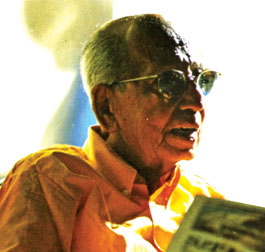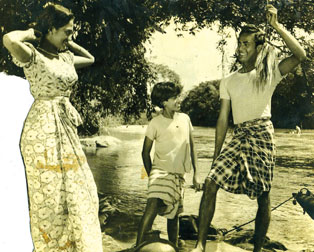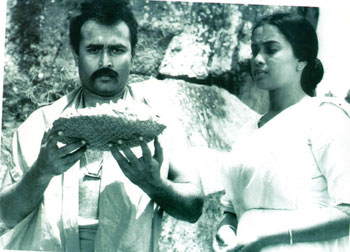|
Reflections on the life and times of the doyen of
Sinhala cinema:
A legendary film-maker who revolutionised Sinhala cinema
By Ranga CHANDRARTHNE
Looking back on Dr. Lester James Peries's trailblazing career in
Sinhala cinema and the evolution of Sinhala cinema from studio-shot
formula films to artistic films of international repute, what is obvious
is that it is Dr. Peries's pioneering attempt with the production of
Rekawa that altered the course of Sinhala cinema. 'Gamperaliya' (Change
in the Village -1964) which has recently been restored is still
appreciated worldwide by diverse audiences. It is one of the instances
where a cinematic masterpiece was made based on a classic Sri Lankan
novel by Martin Wickramasinghe. Gamperaliya as a restores classic is
considered as one of the ten best films of the twentieth century.
 'Nidhanaya', (The Treasure),a brilliant cinematic exploration into
the human psyche is not only a superb cinematic analysis of human psyche
but also a masterpiece of Sinhala cinema, marked for its mature
cinematic diction which is peerless in the annals of Sri Lankan cinema.
A significant facet of Dr. Peries's career in cinema is the sheer
diversity of his creations; 'Gamperaliya' is recognised for its
non-dramatic and realistic depiction of the village, 'Madol Duwa' (The
Enchanted Island -1976) may be evaluated for capturing the lives of
youthful escapade in a Southern coastal village. A living legend, Dr.
Lester James Peries is the only Sri Lankan filmmaker, who belongs to a
generation of legendary filmmakers such as Akira Kurasawa, Satyajith
Ray, Ingmar Bergman. 'Nidhanaya', (The Treasure),a brilliant cinematic exploration into
the human psyche is not only a superb cinematic analysis of human psyche
but also a masterpiece of Sinhala cinema, marked for its mature
cinematic diction which is peerless in the annals of Sri Lankan cinema.
A significant facet of Dr. Peries's career in cinema is the sheer
diversity of his creations; 'Gamperaliya' is recognised for its
non-dramatic and realistic depiction of the village, 'Madol Duwa' (The
Enchanted Island -1976) may be evaluated for capturing the lives of
youthful escapade in a Southern coastal village. A living legend, Dr.
Lester James Peries is the only Sri Lankan filmmaker, who belongs to a
generation of legendary filmmakers such as Akira Kurasawa, Satyajith
Ray, Ingmar Bergman.
Life and times of LJP
Dr. Lester James Peries was born on April 5, 1919, exactly 95 year
ago. As he was born and bred in a Roman Catholic family, his early part
of childhood and much of his adolescent and youth were greatly
influenced by Western way of life. Lester had siblings Erica, Ivan and
Noel.
Lester's was a typical Christian household. Lester's family lived in
Dehiwala spoke only in English at home.
Lester James Peries's only mode of contact with the Sinhala culture
and the village life which subsequently had an abiding influence on his
life and work was through his paternal grandmother who spoke only in
Sinhala.
Dr. James Peries, Lester's father, studied medicine in Scotland and
his mother Anne Gertrude Winifred Jayasuriya was the first girl to pass
the Senior Cambridge examination at St. Bridget's Convent, for which the
school gave a half-a-day holiday.
A little detail of his parents; his father being a kind and reserved
person with interest in horses and cricket who was responsible for
Lester's obsession with cricket and mother, a domineering personality,
indicate a kind of childhood that Lester enjoyed in Sri Lanka before
taking wing to the UK on his mother's insistence to join his brother
Ivan, a painter.
Although Lester's father presented him with an 8mm, Kodasco
projector, his interest in cinema was more or less confined to watching
English films with his brother Ivan. At St. Peter's College, Lester's
favourite subject was English.
His formal school education, however, came to a nabrupt halt at the
age of 17 due to two reasons; the priest's insistence that Lester should
take up robs and his parent's pressure that he should pursue a career.
Career as a journalist
His first breakthrough as a budding writer came when he contributed
to the Blue Pages of the Daily News which was a supplement on art. It
was a supplement which moulded most of the young writers of the day
including Alfreda de Silva, Mervin de Silva, J. B de Alwis, Tarzie
Vittachi and Harrison Pieris.
In 1939 Lester began to write to the Times of Ceylon which was edited
by an Indian, Frank Moraes, the first non-English editor of the
newspaper. In addition, he also reviewed books on a weekly show Radio
Bookshelf at Radio Ceylon. Subsequently all those reviews were
published.
For a brief period Lester was involved in a theatre group known as
the Drama Circle which regularly produced European plays. The other
members of the group include Sali Parakrama, Sita Jayawardena, Osmond
Jayaratne and Ananda Tissa de Alwis.
Two mad Indians in London
Lester who took wing to London on his mother's insistence, stayed in
the spacious flat of his younger brother Ivan who went to the UK on a
scholarship. Ivan who was a prolific painter made almost 1000 paintings
and was a protegee of Martin Russell, a collector who bought most of
Ivan's paintings.
Lionel Wendt who bought Ivan's painting Homage to El Greco (1941)
opened up a vista for both Ivan and Lester of the village life through
his images of Sri Lankan villages and of village folk. They would have
led quite a rebellious life that Lester and Ivan were referred to as Two
mad Indians in London.
However, a significant development that took place before Lester left
Sri Lanka in 1947 was that Franck Moraes, then editor of the Times of
Ceylon, requested Lester to write a weekly piece, titled Letter on the
Art from London. Subsequently, Lester stopped the column and joined the
Times of Ceylon London office as a full-time reporter and feature
writer.
As the amateur film clubs came into being in the UK, Lester's
interest in cinema grew leading to the eventual meeting of Sri Lankans
with similar interest. Perhaps, his meeting with Herword Jansz was
important as Jansz insisted Lester on making a film.
|
 |
|
A scene from Rekhawa |
 |
|
A scene from Nidhanaya |
The result was the birth of a series of experimental films including
A Sinhalese Dance, `Soliloquy` (1949), a short film which won the Mini
Cinema Cup for technical proficiency and `Farewell to Childhood` won the
Best Film Awards in the UK.
One of the turning points in Dr. Lester James Peries life was his
encounter with the distinguished English documentary filmmaker Ralph
Keene, then head of the Government Film Unit (GFU)of Ceylon in 1952 in
London on an assignment given to him by the Editor John Hockin.
This prompted Lester to return to Sri Lanka and he took up duties at
the GFU as the assistant to the chief producer, Ralph Keene. It was
those formative years and the training Lester had at the GFU which laid
the firm foundation for a future filmmaker.
Rekawa, watershed in Sinhala cinema
Before he left the GFU to commence shooting of 'Rekawa' with newly
formed Chitra Lanka Limited in 1955, he co-produced with Keeene two
major documentaries, Heritage of Lanka and Nelungama. His other works at
the GFU include `Conquest in the Dry Zone`, a documentary on controlling
malaria and `Be Safe or Be Sorry`, a witty study on errant motorists.
Subsequently, Lester's colleagues at the GFU William Blake, legendary
cameraman, Titus Thotawatte resigned from the GFU and joined Lester in
his production of 'Rekawa' (The Line of Destiny) in 1956.
'Rekawa' was a watershed in the annals of Sinhala films on many
accounts though it was not a commercial success. It was the first
artistic film and a daring effort that revolutionised Sinhala cinema by
taking the camera out of the studios and into the day light.
One of the significant contributions that it made to cinema was to
break the formula films with triangular love story.
It truly reflects the life in a Sri Lankan village. Among other
things, it marked Sri Lanka on the international arena of films when
'Rekawa' was shown at the tenth Anniversary of Cannes festival in 1956.
In France, Dr. Lester James Peries met Sumitra Gunawardena, his
future partner in life. Subsequently Dr. Lester James Peries married
Sumitra on June 19 1964 while working on 'Sandheshaya' (1960).
Perhaps one of the most influential works of Dr. Lester James Peries
was 'Nidhanaya' (The Treasure in 1970) which is considered as one of the
best films in world cinema. 'Nidhanaya' which is, perhaps, the pinnacle
of Dr. Lester James Peries's trailblazing career shot him to universal
fame among the legendary filmmakers such as Satyajith Ray and Akhira
Kurasawa.
"Fortunately we limited the characters in the early sessions, to a
minimum of five. That was the bachelor Willie Abeynaike (Gamini
Fonseka), the girl with birth marks (Malani Fonseka), the sister who
played a very minor role (Trilicia Gunawardene), the friend who is a
businessman and a man servant who is fairly important.
While working on the story and then shooting the film I didn't
realise that drama was going to be played out entirely between two
people. If you see the film today it is mainly Gamini and Malani in
about 70 per cent of the film.
The film and the narrative are driven by Willie Abeynayaike. Malani
was the ideal foil," stated Dr. Lester James Peries in his biography
'Lester by Lester' as told to Kumar de Silva.
In retrospect, Sinhala cinema grew in leaps and bounds following the
seminal production of 'Rekawa'. Dr. Lester James Peries is fortunate to
see the flourishing of the seed he sowed in generation of filmmakers
including Wasantha Obeysekara, Dharmasena Pathiraja, Dharmasiri
Bandaranayake, Asoka Handagama, Vimukthi Jayasundara, Enoka Satyangani,
Prassanna Vithanage and Sathyajith Maitipe.
However the greatest tribute that contemporary filmmakers can pay to
the doyen of Sinhala cinema is to strive to produce artistic films of
lasting value rather than keeping the filmgoers in darkness for two or
three hours.
Awards
Sri Lankabhimanya The highest Civil Honour of Sri Lanka (2007).
Recipient of the Lifetime Achievement Award at the 31st International
Film Festival of India (2000). Commandeur (commander) in the Ordre des
Arts et des Lettres (Order of Arts and Letters) from the French
government (1997)
Diploma of Honour Venice Film Festival for the film "Conquest In the
Dry Zone" (1954) The Mini Cinema Cup for the short film "Soliloquy" for
displaying the best technical proficiency by the Institute of Amateur
and Experimental Film Makers Festival -Great Britain (1951)
Amateur Cine World Silver Plaque for the experimental film "Farewell
to Childhood" - ten best films of the year - Great Britain (1950) On
April 5, 2002 a stamp was issued on Lester.
In December 2003 he was awarded an honourary doctorate from the
University of Peradeniya.
A hybrid orchid was named after Dr. Lester James Peries on 11th March
2004 - Ascocenda Lester Peries. In 1985 he was awarded an honourary
doctorate in literature (Degree of Doctor of Letters - honoris causa) by
the Colombo University, Sri Lanka.
Filmography
Amma Warune (An Elegy for a Mother, 2007) Wekande Walauwa (Mansion by
the Lake, 2002) Awaragira (The Sunset, 1995) Yuganthaya (The Changing
Village Part 3, 1983) Kaliyugaya (The Time of Kali - The Changing
Village Part 2, 1982) Baddegama (Village in the jungle, 1980) Veera
Puran Appu (Rebellion, 1979) Pinhami (1979) Ahasin Polawata (White
Flowers for the Dead, 1978) Madol Duwa (Enchanted Island, 1976) The God
King (1975) Desa Nisa (The Eyes, 1972) Nidhanaya (The Treasure, 1970)
Akkara Paha (Five Acres of Land, 1969) Golu Hadawatha (Silent Heart,
1968) Ran Salu (The Yellow Robe, 1967) Delovak Athara (Between Two
Worlds, 1966)
Prof. Wimal Dissanayake, an authority on
Asian cinema in an introduction to LJP by A.J Gunawardene calls LJP a
realistic filmmaker: Peries is a realistic filmmaker; realism at the
centre of his poetics of cinema....His desire to represent 'real' people
in 'real' social settings should not be glossed in a way that creates an
impression that he is after a kind of naturalism that was characteristic
of earlier documentary filmmakers. What Lester James Peries tries to
recreate is not raw verisimilitude but poetic verisimilitude. To my
mind, Peries goes beyond the kind of realism advocated by Andre Bazin,
who valarised films as a natural medium for recording natural and
cultural phenomena and viewed with suspicion any authorial intervention
on the part of the director.
Lester James Peries, for his part, while
recognising the importance of verisimilitude also focuses on the
importance of codes and conventions, both cultural and cinematic and the
organising power of the filmmaker in modulating reality and giving it a
sharper definition. He wants his image to be true to Sri Lankan life and
society; at the same time, he wants them to shine with modulated
lyricism. What is interesting about his filmic image is that he elevates
them to a status of poetry without straining for effect or betraying any
affection. That is why I say , that Peries is after a kind of poetic
realism in his cinema. In films such as Rekawa , Gamperaliya, Ran Salu,
Akkara Paha and Wekanda Walawwa, his poetic realism manifest itself in
diverse ways, drawing attention to the breadth of its canvas."
|

